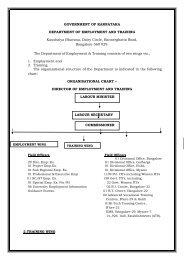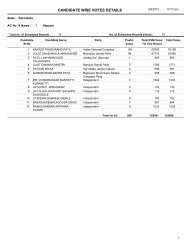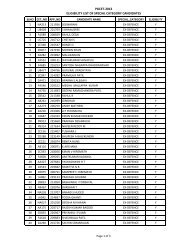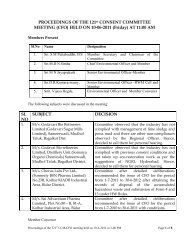7. personality disorders with serious implications in prisons - Nimhans
7. personality disorders with serious implications in prisons - Nimhans
7. personality disorders with serious implications in prisons - Nimhans
You also want an ePaper? Increase the reach of your titles
YUMPU automatically turns print PDFs into web optimized ePapers that Google loves.
al., 2004; Watzke et al., 2006; Black et al., 2007). As per the International Classificationof Diseases, there are ten different types of <strong>personality</strong> <strong>disorders</strong> seen <strong>in</strong> the generalpopulation. However, there are many people <strong>with</strong> temperamental problems <strong>with</strong><strong>in</strong> thegeneral population, which is also reflected <strong>in</strong> the prison population. In this chapter, wefocus more on problematic <strong>personality</strong> <strong>disorders</strong>, which are commonly seen <strong>in</strong> prisonpopulation and are very difficult to manage.Prison populations are known to house certa<strong>in</strong> <strong>personality</strong> <strong>disorders</strong>The common say<strong>in</strong>g about prison is that it houses the „SAD, MAD and BAD‟ of thesociety (Rotter et al., 2002). Sad <strong>in</strong>dicates that at least 50-75% of the prison populationsuffer from depression, Mad depicts that at least 30-15% of them have mental illness andBad suggests that 20-10% of them are psychopaths (Rotter et al., 2002). Personssuffer<strong>in</strong>g from <strong>personality</strong> <strong>disorders</strong> have their reason<strong>in</strong>g powers fully <strong>in</strong>tact; hence noneof the countries have granted <strong>in</strong>sanity defence to those <strong>with</strong> <strong>personality</strong> <strong>disorders</strong>.However, they have been provided <strong>with</strong> an opportunity for treatment and rehabilitation.Prevalence of <strong>personality</strong> <strong>disorders</strong> is high <strong>in</strong> prison population when compared to thegeneral population (Br<strong>in</strong>k, 2005; Andersen, 2004; Butler et al., 2006). In a systematicreview of 62 surveys, it was reported that 65% of the men had <strong>personality</strong> <strong>disorders</strong> <strong>with</strong>47% hav<strong>in</strong>g anti-social <strong>personality</strong> disorder. 42% of the women had <strong>personality</strong> disorderand 21% had anti-social <strong>personality</strong> disorder (Fazel and Danesh, 2002). In another study,prevalence of alcohol and drug addiction was 90%, <strong>personality</strong> <strong>disorders</strong> were 80% andantisocial <strong>personality</strong> disorder was 60% (Langeveld and Melhus, 2004).In a recent study, <strong>personality</strong> disorder was observed <strong>in</strong> 30% of the prison <strong>in</strong>mates. Thedistribution of <strong>personality</strong> <strong>disorders</strong> was as follows; 12% <strong>with</strong> Antisocial Disorder, 12%<strong>with</strong> Borderl<strong>in</strong>e Disorder, 3% <strong>with</strong> Paranoid Disorder, 2% <strong>with</strong> Narcissistic Disorder, and2% and Schizoid disorder (Arroyo and Ortega, 2009). Presence of anti-social <strong>personality</strong>disorder is a high risk for develop<strong>in</strong>g mental illness (Andersen, 2004) and suicide(Verona et al., 2001). Studies have reported that 50% of the mentally ill patients alsohave <strong>personality</strong> disorder. Men had a higher prevalence of alcohol abuse and antisocial<strong>personality</strong>, while women more often showed depression, anxiety <strong>disorders</strong> andborderl<strong>in</strong>e <strong>personality</strong> <strong>disorders</strong> (Watzke et al., 2006).Emotionally unstable <strong>personality</strong> disorder was present <strong>in</strong> 30% of the <strong>in</strong>mates. Thepercentage of women meet<strong>in</strong>g criteria for borderl<strong>in</strong>e <strong>personality</strong> disorder was more than
Emotionally unstable <strong>personality</strong> <strong>disorders</strong>This <strong>personality</strong> is more common among young women. People <strong>with</strong> this <strong>personality</strong>often have difficulty <strong>in</strong> form<strong>in</strong>g and ma<strong>in</strong>ta<strong>in</strong><strong>in</strong>g long last<strong>in</strong>g relationships and can beparticularly vulnerable for impulsive and aggressive acts such as self-harm, suicide, wristslash<strong>in</strong>g and so forth. There is a marked tendency to act impulsively <strong>with</strong>out considerationof the consequences, together <strong>with</strong> mood <strong>in</strong>stability. The ability to plan ahead may bem<strong>in</strong>imal. Outbursts of <strong>in</strong>tense anger may often lead to violence or "behavioural explosions".Two variants of this <strong>personality</strong> disorder are specified, and both share this general theme ofimpulsiveness and lack of self-control.Characteristics of Emotionally Unstable Personality DisorderThere are two variants of emotionally unstable <strong>personality</strong>.Impulsive type characterised by:‣ Impulsivity‣ Emotional/mood <strong>in</strong>stability‣ Inability to plan ahead‣ Outbursts of violence or threaten<strong>in</strong>g behaviour which are commonparticularly <strong>in</strong> response to criticism by others.Borderl<strong>in</strong>e type characterised by:‣ Often unclear or disturbed self-image, aims, and <strong>in</strong>ternal preferences‣ Chronic feel<strong>in</strong>gs of empt<strong>in</strong>ess.‣ Series of suicidal threats or acts of self-harm‣ Liability to become <strong>in</strong>volved <strong>in</strong> <strong>in</strong>tense and unstable relationships‣ Repeated emotional crises and may be associated <strong>with</strong> excessive efforts toavoid abandonmentSource: World Health Organization, 1992Cl<strong>in</strong>ical signs of the disorder <strong>in</strong>clude emotional dysregulation, impulsive aggression,repeated self-<strong>in</strong>jury, and chronic suicidal tendencies, which make these patients frequentusers of mental-health resources.
Management of <strong>personality</strong> <strong>disorders</strong>The behaviour management plan presented here is a guidel<strong>in</strong>e to address the issues of<strong>personality</strong> problems <strong>in</strong> <strong>prisons</strong>. The population <strong>with</strong> <strong>personality</strong> disorder pose a bigchallenge to any correctional and mental health staff. They tend to take up a huge amountof time and resources. Work<strong>in</strong>g <strong>with</strong> offenders <strong>with</strong> <strong>personality</strong> <strong>disorders</strong> can beemotionally very dra<strong>in</strong><strong>in</strong>g and stressful. The reason<strong>in</strong>g power of those <strong>with</strong> <strong>personality</strong>disorder is well preserved; hence treat<strong>in</strong>g them aga<strong>in</strong>st their will is not recommended.However, treatment for <strong>personality</strong> disorder aga<strong>in</strong>st their will is advocated <strong>with</strong> thepermission of the court, <strong>in</strong> certa<strong>in</strong> conditions where the <strong>in</strong>dividual is dangerous to selfand/or others. The best policy is to work <strong>in</strong> partnership <strong>with</strong> people <strong>with</strong> <strong>personality</strong>disorder and help them develop their autonomy and promote choice by ensur<strong>in</strong>g theyrema<strong>in</strong> actively <strong>in</strong>volved <strong>in</strong> f<strong>in</strong>d<strong>in</strong>g solutions to their problems, <strong>in</strong>clud<strong>in</strong>g dur<strong>in</strong>g crisesand encourag<strong>in</strong>g them to consider the different treatment options and life choicesavailable to them, and the consequences of the choices they make (NICE, 2009).Treatment for any comorbid <strong>disorders</strong> should happen regardless of whether the person isreceiv<strong>in</strong>g treatment for <strong>personality</strong> disorder or not. For, example a prisoner <strong>with</strong><strong>personality</strong> disorder us<strong>in</strong>g alcohol and cannabis on a daily basis needs to undergo deaddictionbefore the <strong>personality</strong> disorder is addressed. Develop<strong>in</strong>g a good patient anddoctor relationship is a crucial part of the <strong>in</strong>dividual therapy. A recent literature reviewto know the effect of <strong>personality</strong> disorder on mental illness revealed that the presence of a<strong>personality</strong> disorder is a poor predictor for response to treatment of mental <strong>disorders</strong>(Biel<strong>in</strong>g et al., 2007).The prison behaviour management plan consists of six essential elements:1. Assess<strong>in</strong>g the risks and needs of each <strong>in</strong>mate at various po<strong>in</strong>ts dur<strong>in</strong>g his or herdetention.2. Assign<strong>in</strong>g <strong>in</strong>mates to hous<strong>in</strong>g.3. Meet<strong>in</strong>g basic needs of the <strong>in</strong>mates.4. Def<strong>in</strong><strong>in</strong>g and convey<strong>in</strong>g expectations for <strong>in</strong>mate behaviour.5. Supervis<strong>in</strong>g <strong>in</strong>mates.6. Keep<strong>in</strong>g <strong>in</strong>mates occupied <strong>with</strong> productive activitiesSource: Hutch<strong>in</strong>son et al., 2009
Implement<strong>in</strong>g a prison behaviour management plan requires clear directives, <strong>in</strong> theform of written policies and procedures for each step of the plan. Availability of tra<strong>in</strong>edstaff and supervis<strong>in</strong>g them to ensure that the plan is implemented accord<strong>in</strong>g to theadapted policies and procedures is crucial. Systematic documentation andrecordkeep<strong>in</strong>g of all activities related to the prisoner‟s behaviour management plan isnecessary (Hutch<strong>in</strong>son et al., 2009). Another essential area that is required to beaddressed is needs of the staff to be tra<strong>in</strong>ed <strong>in</strong> crisis management.People <strong>with</strong> <strong>personality</strong> <strong>disorders</strong> are at high risk for press<strong>in</strong>g panic buttons for crisismanagement. Each staff <strong>in</strong> prison needs to be tra<strong>in</strong>ed to face the challenges of crisismanagement. Follow<strong>in</strong>g are the broader aspects to be considered dur<strong>in</strong>g a crisissituation.Skills required <strong>in</strong> crisis management Ensure your safety first, before you <strong>in</strong>tervene Quick response is the key Ma<strong>in</strong>ta<strong>in</strong> a calm, relaxed and concerned look Use of non-threaten<strong>in</strong>g attitude and posture Investigate the reason for crisis quickly Try to understand the crisis from the prisoner‟s po<strong>in</strong>t of view (empathy) Use open ended questions dur<strong>in</strong>g the <strong>in</strong>terview Use counsell<strong>in</strong>g skills to calm the patient down Avoid blam<strong>in</strong>g or scold<strong>in</strong>g Avoid <strong>in</strong>stigat<strong>in</strong>g them Refra<strong>in</strong> from offer<strong>in</strong>g solutions before receiv<strong>in</strong>g full clarification of theproblems and know your limitation and expla<strong>in</strong> them Provide support and short-term help until medical team/ appropriate crisisteam is available Documentation of the <strong>in</strong>cident and action taken is also essential for legalpurposeSource: Modified and adapted from Chandrashekar et al., 2007Management of antisocial <strong>personality</strong> disorderIndividuals <strong>with</strong> antisocial <strong>personality</strong> disorder rarely seek psychiatric help for thedisorder. These <strong>in</strong>dividuals who seek care do so for other problems such as <strong>in</strong>juries,
sexually transmitted diseases, demand<strong>in</strong>g sleep<strong>in</strong>g medic<strong>in</strong>es, alcohol or drug abuse, andsuicidal thoughts. Usually, the court or the prison staff refers them to a mental healthcounsellor for evaluation. They lack <strong>in</strong>sight <strong>in</strong>to their problems. They also reject thediagnosis and help offered. Often they use these opportunities to compla<strong>in</strong> aga<strong>in</strong>st themedical officers for wrong diagnosis or else manipulate transfers to better <strong>in</strong>patientmedical facilities. Hence, antisocial personalities who seek help (or are referred) can beoffered evaluation and treatment as outpatients. Inpatient care needs to evaluated andconsidered if there are suicidal ideas/attempts. In fact, people <strong>with</strong> antisocial <strong>personality</strong>can be disruptive <strong>in</strong> <strong>in</strong>patient units, whenever their demands are not met. Thesepersonalities go to any extent to manipulate the environment <strong>in</strong>clud<strong>in</strong>g deliberate selfharm(wrist cutt<strong>in</strong>g). There are <strong>in</strong>cidents when antisocial prisoners have lost their life bysuicide.To date, there is no treatment available. The failure to cure or even treat such <strong>in</strong>dividualshas divided the medical and legal communities, as well as society <strong>in</strong> general. They areknown to manipulate the situations, be litigious and bear grudges. They are well knownto split the staff by compla<strong>in</strong><strong>in</strong>g to one staff aga<strong>in</strong>st the other. Generally, compla<strong>in</strong>tsreceived by these <strong>in</strong>dividuals aga<strong>in</strong>st the staff are of malicious <strong>in</strong>tent. Hence, suchcompla<strong>in</strong>ts need to be thoroughly verified and <strong>in</strong>vestigated before proceed<strong>in</strong>g aga<strong>in</strong>st thestaff.Though there is no cure for this disorder, it is crucial to identify and manage these<strong>in</strong>dividuals <strong>in</strong>side the prison to ensure that they do not create trouble for others <strong>in</strong> theprison. A large part of the problems <strong>in</strong>side the prison are attributable to this group. Staffshould learn to handle these prisoners. These prisoners do well <strong>in</strong> structured and highsecurity<strong>prisons</strong>. However, psychotropic medic<strong>in</strong>es are found to be very useful <strong>in</strong>emergency and certa<strong>in</strong> <strong>in</strong>evitable situations such as violence, aggression, suicide,deliberate self-harm, demand<strong>in</strong>g behaviours and illicit drug <strong>in</strong>toxication related abnormalbehaviour. The medic<strong>in</strong>es are also useful to decrease their aggression <strong>in</strong> the long run.Treatment for any comorbid <strong>disorders</strong> should be given regardless of whether the person isreceiv<strong>in</strong>g treatment for antisocial <strong>personality</strong> disorder or not, because such people areoften excluded from rout<strong>in</strong>e care (Black et al., 2010). Suicidal threats and deliberate selfharm are very common <strong>in</strong> this population. The tendency to rationalise irresponsible acts,m<strong>in</strong>imise the consequences of these acts, violence and manipulative behaviour, needs tobe confronted on a daily and immediate basis. Close supervision <strong>with</strong> structured activityhave been recommended. The most effective treatment may at times be simply to
consider high-security <strong>prisons</strong>. Many antisocial behaviours do tend to dissipate (orburnout) <strong>with</strong> time (Kay J and Tasman A, 2006; Frosch, 1983). There are studies done <strong>in</strong>the community which reported that cognitive behaviour therapy for violent men <strong>with</strong>antisocial <strong>personality</strong> disorder <strong>in</strong> the community did not show any improvement(Davidson et al., 2009).Various countries have adopted different policies to manage prisoners <strong>with</strong> antisocial<strong>personality</strong> disorder. Majority of these policies are an immediate aftermath of certa<strong>in</strong><strong>in</strong>cidents. In 1998, England was shocked by the apparently motiveless murders of amother and two of her children by a person <strong>with</strong> <strong>personality</strong> disorder. He was convictedof their murders. Later, the government was determ<strong>in</strong>ed to prevent this type of offencefrom recurr<strong>in</strong>g. Hence, <strong>in</strong> 1999 the UK government <strong>in</strong>troduced a new concept calleddangerous and severe <strong>personality</strong> disorder (DSPD). DSPD is a highly contentious conceptand is not a medical diagnosis; it refers to the perceived levels of dangerousness of the<strong>in</strong>dividual to the society or to others. DSPD unit has subsequently become a treatmentand assessment programme for <strong>in</strong>dividuals who satisfy three requirements: (1) have asevere disorder of <strong>personality</strong>, (2) present a significant risk of caus<strong>in</strong>g <strong>serious</strong> physical orpsychological harm from which the victim would f<strong>in</strong>d it difficult or impossible torecover, and (3) the risk of offend<strong>in</strong>g should be functionally l<strong>in</strong>ked to the <strong>personality</strong>disorder (Maden and Tyrer, 2003). Later, the UK government proposed a preventivedetention programme to those <strong>with</strong> dangerous and severe <strong>personality</strong> disorder (Kendell,2002).To manage these <strong>in</strong>dividuals, various countries have adopted closed monitor<strong>in</strong>g systemssuch as „supermax <strong>prisons</strong>‟ or „special hous<strong>in</strong>g units‟ (Pizarro and Narag 2008, Mears2008). Supermax <strong>prisons</strong> are those <strong>with</strong> high level of security <strong>with</strong> electronically operateddoors, surveillance cameras, and no w<strong>in</strong>dows. Visitors are also not allowed <strong>in</strong>side (Mearsand Castro 2006). A special hous<strong>in</strong>g unit is a solitary conf<strong>in</strong>ement of the prisoners <strong>in</strong> aclosed room <strong>with</strong>out w<strong>in</strong>dows and they are generally allowed out of their cells for onlyone hour a day. These are managed by us<strong>in</strong>g proper protocol and for limited periods only(Mears 2008). However, these k<strong>in</strong>ds of sett<strong>in</strong>gs are often misused by the prisonauthorities and also very costly to ma<strong>in</strong>ta<strong>in</strong> such <strong>prisons</strong> (Pizarro and Narag 2008, Mears2008). Certa<strong>in</strong> <strong>in</strong>dividuals <strong>with</strong> antisocial <strong>personality</strong> disorder <strong>with</strong> severe violence andaggressive tendency need isolation. But the need for cont<strong>in</strong>u<strong>in</strong>g to keep them <strong>in</strong> suchsett<strong>in</strong>gs needs to be assessed periodically by risk assessment and the decision needs totaken by a group of professionals such as representative of a judiciary, prisonadm<strong>in</strong>istration, medical staff, and social worker so that human rights violations are
monitored closely. This needs to be documented. F<strong>in</strong>ally, management of prisoners <strong>with</strong>antisocial <strong>personality</strong> should be focused on provid<strong>in</strong>g symptomatic relief and clearguidel<strong>in</strong>es about expected behavior from them <strong>in</strong> prison. However, there is an urgentneed to do research to answer, whether supermax prions are warranted, effective, orefficient <strong>in</strong> Indian sett<strong>in</strong>gs.Management of emotionally unstable (Borderl<strong>in</strong>e) <strong>personality</strong> disorderBorderl<strong>in</strong>e <strong>personality</strong> disorder is characterised by a pervasive pattern of <strong>in</strong>stability <strong>in</strong>affect regulation, impulse control, <strong>in</strong>terpersonal relationships, and self-image. Mood<strong>disorders</strong>, substance-related <strong>disorders</strong>, eat<strong>in</strong>g <strong>disorders</strong> (usually Bulimia), posttraumaticstress disorder, attention-deficit/hyperactivity disorder, suicide, deliberate self-harm andother <strong>personality</strong> <strong>disorders</strong> frequently co-occur <strong>with</strong> this disorder (Lieb et al., 2004;Zanar<strong>in</strong>i et al., 1998; Gunderson and Ridolfi, 2001; Paris, 2005; NICE, 2009). Oncompar<strong>in</strong>g <strong>in</strong>dividuals <strong>with</strong> antisocial <strong>personality</strong> <strong>disorders</strong> <strong>with</strong> those <strong>with</strong> emotionallyunstable <strong>personality</strong> disorder, it has been found that <strong>in</strong> case of the latter, patients improve<strong>with</strong> time. There is an evidence base for treatment us<strong>in</strong>g both psychotherapy andpsychopharmacology <strong>in</strong> emotionally unstable personalities (Paris, 2005; NICE, 2009).Dialectical behaviour therapy, cognitive behaviour therapy, <strong>in</strong>terpersonal therapy,systems tra<strong>in</strong><strong>in</strong>g for emotional predictability and problem solv<strong>in</strong>g (STEPPS) programmesare effective treatments. Psychotropic medications are effective <strong>in</strong> treat<strong>in</strong>g emotional,impulsive, mood sw<strong>in</strong>gs and depressive symptoms that frequently are associated <strong>with</strong>borderl<strong>in</strong>e disorder. Medic<strong>in</strong>es can reduce depression, anxiety, and impulsive aggressionbut need to be used judiciously used and supervised. (Lieb et al., 2004; Paris 2005;American Psychiatric Association, 2001).Suicidal threats and deliberate self harm are very common <strong>in</strong> prisoners <strong>with</strong> emotionallyunstable <strong>personality</strong> (Gunderson and Ridolfi, 2001). There is a need to sensitise staffabout the suicide threats. There are <strong>in</strong>cidents when prison staff has challenged theprisoner‟s suicidal ideas or threats by say<strong>in</strong>g „your suicidal threats are just an act‟. Thishas lead to actual suicidal attempt by the prisoners. There is an urgent need to implementsuicide prevention strategies <strong>in</strong>side the prison. Staff needs to be tra<strong>in</strong>ed <strong>in</strong> handl<strong>in</strong>g theseprisoners.Personality <strong>disorders</strong> are a common form of mental health problems seen <strong>in</strong> <strong>prisons</strong>.Manag<strong>in</strong>g antisocial <strong>personality</strong> disorder and emotionally unstable <strong>personality</strong> <strong>in</strong> prison
is a challenge to any staff and mental health team. The prison adm<strong>in</strong>istration should beaware of the symptoms of these <strong>personality</strong> <strong>disorders</strong>. Antisocial <strong>personality</strong> <strong>disorders</strong> dowell <strong>in</strong> a highly secured and structured environment. The borderl<strong>in</strong>e <strong>personality</strong> disorderneeds therapy. Co-morbid conditions need to be treated irrespective of the treatmentstatus of the <strong>personality</strong> disorder. Prison staff plays a crucial role <strong>in</strong> prevent<strong>in</strong>g suicide.They need to be tra<strong>in</strong>ed <strong>in</strong> manag<strong>in</strong>g suicide and deliberate self-harm <strong>in</strong>side the prison.In conclusion, there are <strong>in</strong>deed certa<strong>in</strong> groups of people who by virtue of theirdysfunctional <strong>personality</strong> are more prone to crimes. There are those who may havecommitted crimes as a way of cop<strong>in</strong>g <strong>with</strong> stressful situations or have made an error <strong>in</strong>judgement by tak<strong>in</strong>g law <strong>in</strong>to their hands. While <strong>in</strong> case of the former, br<strong>in</strong>g<strong>in</strong>g about achange <strong>in</strong> the <strong>personality</strong> while <strong>in</strong> prison might be a herculean task, <strong>in</strong> case of the latter,appropriate counsell<strong>in</strong>g and behavioural <strong>in</strong>terventions can help by prevent<strong>in</strong>g thedysfunctional behaviours and thought process lead<strong>in</strong>g to the crime from becom<strong>in</strong>g<strong>in</strong>gra<strong>in</strong>ed as part of the <strong>personality</strong>.
ReferencesAmerican Psychiatric Association 2000. Diagnostic and Statistical Manual of MentalDisorders, 4th Edition, Text Revision. Wash<strong>in</strong>gton, DCAmerican Psychiatric Association. Practice guidel<strong>in</strong>e for the treatment of patients <strong>with</strong>borderl<strong>in</strong>e <strong>personality</strong> disorder. Am J Psychiatry 2001; 158:1–52Andersen H. Mental health <strong>in</strong> prison populations. A review–<strong>with</strong> special emphasis on astudy of Danish prisoners on remand. Acta Psychiatrica Scand<strong>in</strong>avica 2004;110:5-59Arroyo J, Ortega E. Personality <strong>disorders</strong> amongst <strong>in</strong>matesas a distort<strong>in</strong>g factor <strong>in</strong> theprison social climate. Rev Esp Sanid Penit 2009;11:11-15Assadi S, Noroozian M, Pakravannejad M, Yahyazadeh O, Aghayan S, Shariat S, FazelS. Psychiatric morbidity among sentenced prisoners: prevalence study <strong>in</strong> Iran. TheBr J Psychiatry 2006;188:159-164Biel<strong>in</strong>g PJ, Green SM, Macqueen G. The impact of <strong>personality</strong> <strong>disorders</strong> on treatmentoutcome <strong>in</strong> bipolar disorder: A review. Personality and Mental Health 2007;1:2-13Black DW, Gunter T, Allen J, Blum N, Arndt S, Wenman G, Sieleni B. Borderl<strong>in</strong>e<strong>personality</strong> disorder <strong>in</strong> male and female offenders newly committed to prison.Compr Psychiatry 2007;48:400-405Black DW, Gunter T, Loveless P, Allen J, Sieleni B. Antisocial <strong>personality</strong> disorder <strong>in</strong><strong>in</strong>carcerated offenders: Psychiatric comorbidity and quality of life. Ann Cl<strong>in</strong>Psychiatry 2010;22:113-120Br<strong>in</strong>k J. Epidemiology of mental illness <strong>in</strong> a correctional system. Curr Op<strong>in</strong> Psychiatry2005;18:536-541Butler T, Andrews G, Allnutt S, Sakashita C, Smith NE, Basson J. Mental <strong>disorders</strong> <strong>in</strong>Australian prisoners: a comparison <strong>with</strong> a community sample. Aust NZJ Psychiatry2006;40:272-276Chandrashekar CR, Math SB, Kishore Kumar KV, Moily S, Raghuram A, ParthasarathyR, Johnson R 200<strong>7.</strong> Manual on Strudents' Counsell<strong>in</strong>g for College Teachers. 3rdEdition. Editor: Dr. C.R. Chandrashekar. Publisher: National Institute of MentalHealth and Neuro Sciences (NIMHANS), BangaloreCoid J, Ullrich S. Antisocial <strong>personality</strong> disorder is on a cont<strong>in</strong>uum <strong>with</strong> psychopathy.Compr Psychiatry 2010;51:426-433Davidson KM, Tyrer P, Tata P, Cooke D, Gumley A, Ford I, Walker A, Bezlyak V,Seivewright H, Robertson H, Crawford MJ. Cognitive behaviour therapy for violentmen <strong>with</strong> antisocial <strong>personality</strong> disorder <strong>in</strong> the community: an exploratoryrandomized controlled trial. Psychol Med 2009;39:569-577
Dunsieth NW, Jr., Nelson EB, Brusman-Lov<strong>in</strong>s LA, Holcomb JL, Beckman D, WelgeJA, Roby D, Taylor P, Soutullo CA, McElroy SL. Psychiatric and legal features of113 men convicted of sexual offenses. J Cl<strong>in</strong> Psychiatry 2004; 65:293-300Fazel S, Danesh J. Serious mental disorder <strong>in</strong> 23 000 prisoners: a systematic review of 62surveys. Lancet 2002;359:545-550Fountoulakis KN, Leucht S, Kapr<strong>in</strong>is GS. Personality <strong>disorders</strong> and violence. Curr Op<strong>in</strong>Psychiatry 2008;21:84-92Frosch JP. The Treatment of Antisocial and Borderl<strong>in</strong>e Personality Disorders. HospCommunity Psychiatry 1983;34:243-248Goldsmith HH, Buss A, Plom<strong>in</strong> R, Rothbart MK, Thomas A, Chess S, H<strong>in</strong>de RA, McCallRB. What is temperament? Four approaches. Child Dev 1987; 58: 505–529Gunderson JG, Ridolfi ME. Borderl<strong>in</strong>e Personality Disorder. Ann New York Acad Sci2001;932:61-77Hales R, Yudofsky S,Gabbard G 2008. The American Psychiatric Publish<strong>in</strong>g Textbook ofPsychiatry: American Psychiatric Publish<strong>in</strong>gHutch<strong>in</strong>son V, Keller K, Reid T, Mart<strong>in</strong> M 2009. Corrections NIo. Inmate behaviormanagement: the key to a safe and secure jail. Available onl<strong>in</strong>e athttp://nicic.gov/Downloads/PDF/Library/023882.pdf accessed on 12.12.2010 USDept. of Justice, National Institute of Corrections. Accessed on 06.09.2010.Kay J, Tasman A 2006. Essentials of psychiatry, Pub John Wiley & Sons Ltd, England:WileyKendell RE. The dist<strong>in</strong>ction between <strong>personality</strong> disorder and mental illness. Br JPsychiatry 2002;180:110-115Langeveld H, Melhus H. Are psychiatric <strong>disorders</strong> identified and treated by <strong>in</strong>-prisonhealth services? Tidsskr Nor Laegeforen 2004;124:2094-2097Lieb K, Zanar<strong>in</strong>i MC, Schmahl C, L<strong>in</strong>ehan MM, Bohus M. Borderl<strong>in</strong>e <strong>personality</strong>disorder. Lancet 2004;364:453-461Maden T, Tyrer P. Dangerous and severe <strong>personality</strong> <strong>disorders</strong>: a new <strong>personality</strong>concept from the United K<strong>in</strong>gdom. J Personality Dis 2003;17:489-496Math SB, Murthy P, Parthasarathy R, Naveen Kumar C, Madhusudhan S 2011. Mentalhealth and substance use problems <strong>in</strong> <strong>prisons</strong>: Local lessons for national action.Publication, National Institute of Mental Health Neuro Sciences, Bangalore.Mears DP. An assessment of supermax <strong>prisons</strong> us<strong>in</strong>g an evaluation research framework.The Prison Journal 2008;88: 43-68Mears DP, Castro JL. Wardens' views on the wisdom of supermax <strong>prisons</strong>. Crime &Del<strong>in</strong>quency 2006; 52: 398-431
Millon T 1981. Disorders of <strong>personality</strong>- DSM-III: Axis-II New York, WileyMillon T 198<strong>7.</strong> Millon Cl<strong>in</strong>ical multiaxial Inventory-II Manual, M<strong>in</strong>netonka MN,National computer systemNICE 2009. Borderl<strong>in</strong>e <strong>personality</strong> disorder (BPD): quick reference guide to the NICEGuidel<strong>in</strong>es. National Institute for Health and Cl<strong>in</strong>ical Excellence, London.Available onl<strong>in</strong>e at http://www.nice.org.uk/nicemedia/live/12125/42900/42900.pdfAccessed on 06.09.2010.Paris J. Antisocial and borderl<strong>in</strong>e <strong>personality</strong> <strong>disorders</strong>: Two separate diagnoses or twoaspects of the same psychopathology? ComprPsychiatry 1997;38:237-242Paris J. Borderl<strong>in</strong>e <strong>personality</strong> disorder. CMAJ 2005;172:1579-1583Pizarro JM, Narag RE. Supermax Prisons. The Prison Journal 2008; 88: 23-42Reich J, Yates W, Nduaguba M. Prevalence of DSM-III <strong>personality</strong> <strong>disorders</strong> <strong>in</strong> thecommunity. Soc Psychiatry Psychiatr Epidemiol1989; 24:12-16Rothbart MK 1989. Temperament <strong>in</strong> childhood: A framework. In: Kohnstamm GA, BatesJE, Rothbart MK, eds. Temperament <strong>in</strong> childhood. Oxford, United K<strong>in</strong>gdom: JohnWiley and Sons pp59-73Rotter M, Way B, Ste<strong>in</strong>bacher M, Sawyer D, Smith H. Personality <strong>disorders</strong> <strong>in</strong> prison:aren't they all antisocial? Psychiatr Q 2002;73:337-349Torgersen S, Kr<strong>in</strong>glen E, Cramer V. The prevalence of <strong>personality</strong> <strong>disorders</strong> <strong>in</strong> acommunity sample. Arch Gen Psychiatry 2001;58:590Verona E, Patrick C, Jo<strong>in</strong>er T. Psychopathy, antisocial <strong>personality</strong>, and suicide risk. JAbnorm Psychol 2001;110: 462-470Warren JI, Burnette M, South SC, Chauhan P, Bale R, Friend R. Personality <strong>disorders</strong>and violence among female prison <strong>in</strong>mates. J Am Acad Psychiatry Law2002;30:502-509Watzke S, Ullrich S, Marneros A. Gender and violence-related prevalence of mental<strong>disorders</strong> <strong>in</strong> prisoners. Eur Arch Psychiatry Cl<strong>in</strong> Neurosci 2006;256:414-421World Health Organization 1992. International Statistical Classification of Diseases andRelated Health Problems, 10th Revision. GenevaZanar<strong>in</strong>i MC, Frankenburg FR, Dubo ED, Sickel AE, Trikha A, Lev<strong>in</strong> A, Reynolds V.Axis II comorbidity of borderl<strong>in</strong>e <strong>personality</strong> disorder. Compr Psychiatry1998;39:296-302
















